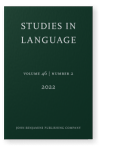Vol. 46:2 (2022) ► pp.453–516
Predicting voice choice in symmetrical voice languages
All the things that do not work in Totoli
Western Austronesian symmetrical voice languages exhibit at least two basic transitive constructions. This paper investigates what factors influence speakers’ choice of one voice over another in natural spoken discourse. It provides a thorough assessment of all factors that have been proposed to be relevant for voice choice in the literature on symmetrical voice systems. Using the Indonesian language Totoli as a case study, we show that unlike in languages with asymmetrical voice alternations, argument-related properties such as topicality, activation state, animacy, etc. do not play a major role in voice choice in symmetrical voice languages. We argue that for symmetrical voice alternations other factor groups are relevant than for asymmetrical voice alternations and that the clear structural differences between the two alternation types are mirrored in functional differences.
Article outline
- 1.Introduction
- 2.Language, corpus and methods
- 2.1Totoli
- 2.2Corpus
- 2.3Corpus annotation
- 2.4Summary and note on statistics model
- 3.Argument-related factors
- 3.1Argument-inherent properties: Animacy and humanness
- 3.2Discourse-related properties: Activation state, topicality, discourse reference function, generalizability
- 3.2.1Topicality
- 3.2.2Activation state and argument realization
- 3.2.3Tracking use
- 3.2.4Generalizability
- 4.Verb/clause-related factors
- 4.1Grounding
- 4.1.1Discourse transitivity and subordination
- 4.1.2Valency-increasing morphology
- 4.2Collostruction strength
- 4.1Grounding
- 5.Structural priming
- 6.Interactivity and text type
- 7.Statistical analysis
- 8.Discussion
- 9.Conclusion
- Acknowledgements
- Notes
- Abbreviations
-
References
